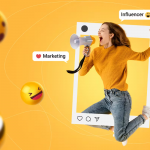Influencer Marketing, Marketing Solution
The Perfect Pair: How Influencer Marketing Boosts Performance Marketing Campaigns
17 Jan

In the ever-changing world of digital marketing in Malaysia, identifying techniques that complement and amplify one another is critical to accomplishing exceptional results. Influencer marketing agency and performance marketing agency are two examples of such a powerful combination. When intelligently coupled, these two tactics can generate a synergy that raises brand recognition and leads to measurable outcomes. Let’s examine how influencer agency Malaysia can take your performance marketing efforts to new heights.
Understanding the Basics
Before we dive into influencer marketing and performance marketing, let’s have some basic knowledge about these 2 marketing strategies.
Influencer marketing involves partnering with individuals who have a strong online presence and a loyal following. These influencers promote your products or services, leveraging their credibility and reach to drive engagement and awareness.
On the other hand, performance marketing is a data-driven approach focused on measurable outcomes like clicks, leads, and sales. It relies on precise targeting, real-time analytics, and optimization to achieve tangible results.
To learn more about influencer marketing services and performance marketing agency feel free to click the 2 links.
Differences Between Influencer Marketing Agency and KOL Agency
There is also a common confusion between influencers and key opinion leaders (KOLs). These two roles address separate marketing demands and methods. Let’s look at the key differences between KOLs and influencers and also how organizations may effectively harness them.
Influencers
Influencers are individuals who have cultivated large followings on social media platforms such as Instagram, Facebook, and TikTok. Their popularity often stems from their engaging content, relatable personalities, and ability to connect with their audience on a personal level. Influencers excel in promoting products through:
- Product Placements: Subtly showcasing a product within their posts.
- Endorsements: Sharing their positive experiences with a product.
- Recommendations: Actively encourage their followers to try a product.
The primary strength of influencers lies in their ability to amplify brand awareness and drive traffic by leveraging their fan base. They are particularly effective for campaigns aimed at reaching a broad audience and creating a buzz around a product or service.
KOLs
Key Opinion Leaders (KOLs) are industry-specific experts or authorities. Unlike influencers, KOLs’ legitimacy stems from their expertise, accomplishments, or professional history, not their social media following. KOLs are credible voices in industries such as:
- Business and technology: Well-known CEOs or tech innovators.
- Science and healthcare: Distinguished researchers or physicians.
- Fashion and lifestyle: designers or specialties who are industry experts.
While KOLs may not necessarily have large social media followings, their opinions are highly valued within their niches. Collaborating with key opinion leaders (KOLs) can help brands create trust and credibility, especially when targeting a niche demographic.
Key Differences Between KOLs and Influencers
Aspect | Influencers | KOLs |
Primary Platform | Social media | Industry-specific forums or networks |
Audience | General, broad | Niche, highly relevant |
Focus | Popularity and relatability | Expertise and authority |
Reach | Wide | Targeted |
Trust Factor | Personal connection | Professional Credibility |
From Awareness to Action: How Influencer and Performance Marketing Differ
For influencer marketing strategy and performance marketing strategy to work well together, we must first understand each other’s characteristics.
Perspective | Influencers Marketing | Performance Marketing |
Objective | Primarily aim to enhance brand awareness and engagement. They collaborate with influencers who have large followings on platforms like Instagram, TikTok, and YouTube to amplify a brand’s visibility and appeal. | Concentrate on customer acquisition and measurable outcomes. They drive specific actions, such as purchases or sign-ups, using commission-based partnerships. |
Platforms | Dominates on visual and interactive platforms like Instagram, TikTok, Facebook, and YouTube, where personality-driven content thrives. | Excels on platforms like blogs and YouTube, where creators have greater editorial control and can integrate affiliate links or direct calls-to-action seamlessly. |
Strength |
|
|
Challenges |
|
|
Integrating both influencer marketing agency and performance marketing agency can result in a powerful mix of awareness and action. By leveraging influencers for reach and performance marketers for measurable results, brands can create a balanced and impactful marketing plan.
Understanding these contrasts enables brands to connect their objectives with the appropriate marketing strategy, ensuring that campaigns generate optimum value.
How to Make Performance Marketing and Influencer Marketing Work Together?
Influencer and performance marketing has typically been distinguished by their focus on different goals: influencer reach and engagement, performance conversions, and ROI. However, the boundaries are dissolving, and combining these tactics can yield spectacular outcomes. Here’s how to successfully integrate them:
1. Plan as One: A Unified Marketing Funnel
Influencer and performance marketing agency frequently cross in the consumer journey. For example, an influencer’s post may pique someone’s attention, prompting them to conduct a branded search on Google and eventually make a purchase through a retargeting advertisement. Recognizing these overlaps is critical.
By determining where each channel fits into the larger funnel, marketers can coordinate their efforts to create a smooth consumer journey. Instead of viewing influencer content as solely top-of-funnel and performance ads as bottom-of-funnel, evaluate how they complement and reinforce one another at each level.
2. Align Metrics and Measurement
Measurement silos might produce contradicting narratives. Influencer marketing agency campaigns may highlight reach and engagement, whereas performance campaigns emphasize conversions. To acquire a comprehensive perspective, connect attribution models and evaluate data together.
For example, if an influencer marketing campaign increases branded search searches or enhances sponsored social engagement, the results should be shared across departments. Experimentation, such as modifying budgets or testing cross-channel synergy, might uncover useful patterns and help improve future campaigns.
3. Share Audience Insights Across Channels
Audience data is a goldmine for both influencer and performance marketing. Influencer campaigns often target specific demographics or interests, generating insights that can refine performance strategies.
For example, if eco-conscious audiences respond well to an influencer campaign, this insight can inform keyword bidding strategies or audience targeting for paid search and display ads. Conversely, performance data can identify new audience segments for influencer partnerships, creating a feedback loop that enhances both channels.
4. Leverage Creative Insights Across Channels
The creative learnings from one channel can significantly benefit the other. High-performing influencer content, for instance, can inspire ad copy or visual elements for performance campaigns. Similarly, the best-performing headlines or CTAs from paid search can guide influencer messaging.
Comments and feedback from social media audiences are another untapped resource. Positive user comments can serve as authentic testimonials in ads while recurring themes can inform future influencer collaborations.
5. Collaborate on Content for Maximum Impact
Most Influencer Marketing Agency Malaysia’s generated content is not only authentic but also cost-effective compared to studio-produced assets. When repurposed for paid campaigns, IGC combines relatability with the precision of audience targeting, delivering exceptional results.
Platforms like Meta and TikTok now offer tools to amplify influencer content directly through creator accounts, preserving authenticity while leveraging paid media’s scalability. For example:
- Meta Branded Content Ads: Ads appear from the influencer’s handle, maintaining transparency with a “paid partnership” label. These ads have been shown to increase purchase likelihood by 82% and lift conversions by 2.4x.
- TikTok Spark Ads: Similar to Meta’s offering, Spark Ads let brands boost organic influencer content, blending seamlessly into users’ feeds while driving engagement and conversions.
Integrating Influencer Marketing and Performance Marketing: A Winning Strategy for DoMedia
Influencer marketing and performance marketing are highly effective strategies that have acquired substantial traction. By integrating these two strategies, it will boost a brand’s reach, engagement, and ROI effectively. Here is how to successfully mix influencer and performance marketing methods to build a comprehensive and impactful campaign.
1. Understanding the Strengths of Both Approaches.
Collaboration with influencers that have a loyal following helps to increase brand exposure and trust. On the other hand, performance marketing focuses on driving measurable results like as clicks, conversions, and purchases. By combining the two, marketers can utilize the influencer’s reach while guaranteeing that their efforts yield actual, trackable outcomes.
2. Establish clear objectives and KPIs.
Setting up clear objectives is needed for properly integrating both influencers and performance marketing strategy. Whether the goal is to increase brand exposure, engagement, or revenue, identifying particular Key Performance Indicators (KPIs) ensures that influencer and performance marketing activities are linked. Metrics such as conversion rates and cost per click can be used to measure success and optimize strategies.
3. Use data to optimize campaigns.
Performance marketing generates useful data on customer behavior that may be used to improve influencer initiatives. By assessing which influencers create the greatest engagement and conversions, clients can alter their strategy in real-time. This data-driven approach guarantees that marketing funds are spent wisely and tailors content to specific audience demographics.
4. Incorporate CTA and trackable links.
Involve both call-to-actions (CTAs) and trackable links in influencer collaborations closing the gap between these two strategies. This allows Influencers to motivate their followers to take action like visiting your website or making a purchase. Using affiliate links or special promo codes, brands may analyze conversions and determine the direct impact of each influencer’s efforts.
5. Build long-term relationships with influencers.
While short-term initiatives might produce instant benefits, combining influencer marketing and performance marketing works best when you establish long-term connections with influencers. This enables consistent messaging, increased brand loyalty, and more sustainable growth. Influencers that connect with your brand can drive long-term performance, adding value beyond a single campaign.
Conclusion
Integrating influencer and performance marketing creates a dynamic approach to digital marketing that blends the power of trust and authenticity with quantitative outcomes. Brands can design campaigns that reach a larger audience while also driving meaningful conversions by establishing clear objectives, harnessing data, adding trackable links, and cultivating long-term influencer relationships. DoMedia sees this integration as a tremendous opportunity to engage with customers on a deeper level while optimizing marketing activities for maximum impact. Contact us now.
Tags
Ad Copies Ad Results Advertorial Ad Visuals Affiliate Marketing App Install Ads Awards & Recognition B2B Branding Campaign Optimization Content Marketing Conversion Driven Creative Agency Customer Engagement Data-Driven Data Analytics Digital Marketing Agency Digital Marketing Strategy E-Commerce Platform Facebook Featured Content Google Ads Influencer Marketing Influencers Instagram KOL Lazada Lead Generation Linkedin Marketplace Microsoft Bing Search Native Ads Performance Marketing Performance Marketing Agency Return on Ad Spend (ROAS) Return on Investment (ROI) SEM Shopee SME Social Media Ads Social Media Management Social Media Marketing Target Audience TikTok Ads User Engagement
Interested? Lets work together!



